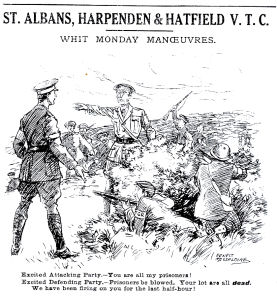
Herts V. R.
An Account of the Hertfordshire Volunteer Regiment and other Units of the Volunteer Training Corps and Volunteer Forces raised in Hertfordshire, 1914-1921
by J. D. Sainsbury
Published by Hart Books, Welwyn, 2005
A4 Paperback, 132 pages
ISBN 0 948527 08 0
|
Contents Preface and Acknowledgements PART 1 CONSTITUTION, ORGANISATION AND ROLE Chapter 1. The National Background 2. The Volunteer Training Corps and the Volunteer Force in Hertfordshire PART 2 UNIFORMS, ARMS AND EQUIPMENT 3. The National Background 4. The Volunteer Training Corps and the Volunteer Force in Hertfordshire Appendices 1. Principal Acts of Parliament and Statutory Orders2. Selected War Office Instructions, Army Council Instructions, Volunteer Force Orders and Army Orders 3. Establishments 4. Constitution of the Hertfordshire Volunteer Regiment, May 1915 5. Lists of Officers 6. Roll of Honour 7. Honours and Awards Annotated Bibliography and Guide to Sources |
HERTFORDSHIRE VOLUNTEER REGIMENT:
COMPANY ORGANISATION DECEMBER 1915
| 1st Battalion | 2nd Battalion | 3rd Battalion | 4th Battalion | |
| (East Herts) | (West Herts) | (Mid Herts) | (South Herts) | |
|
Battalion Headquarters |
Bishop's Stortford |
Watford |
St. Albans |
New Barnet |
|
No.1 Company |
Bishop's Stortford and District; Royston |
Watford |
St. Albans |
New Barnet |
|
No.2 Company |
Hitchin, Stevenage and Knebworth |
Chorleywood, Croxley Green and Rickmansworth |
St. Albans |
High Barnet |
|
No.3 Company |
Hertford and District |
Berkhamsted and Tring |
Harpenden |
|
|
No.4 Company |
Hoddesdon, Ware and Stanstead Abbotts |
Hemel Hempstead, Boxmoor and Little Gaddesden |
Hatfield |
|
| No.5 Company | Letchworth | Bushey and Bushey Heath |
[Source: Hertfordshire Almanac, 1916]
This is another excellent military history from the pen of J.D. Salisbury. It is well researched and written, with some very useful appendices (with many names) and references to sources. It throws light on an often unreported side of the war - the Volunteer Units which were the equivalent of the "Dad's Army" of the Second World War.
Sample Extract on Exercises on No Mans Land Common
Although they sought help from locally-based units of the Regular Army or Territorial Force, sub-units of the Volunteer Training Corps in Hertfordshire relied to a great extent upon former members of the Armed Forces, including, of course, the pre-1908 Volunteer Force and the Territorial Force, for elementary drill and musketry training. Drill was, in any case, commonly taught in schools in those days and the services of local drill instructors, who also covered physical training, were readily available. (One of these instructors, W. Abbiss, a well known figure in Hitchin, was immediately nominated a platoon-sergeant in the Hitchin corps and it would not be surprising if many other similar appointments were made.) In the early weeks of 1915 the routine settled down - two or three evening 'drills' a week, possibly one other evening for small-bore rifle shooting if a local indoor range was available, and a Sunday morning 'drill', used in fine weather for route marches or simple tactical exercises. Some corps held an Easter 'camp', or at least a full day's training, during the Easter weekend of 1915 and it became customary for bank holidays to be devoted to field training or range work. The details can be followed not only in the Hitchin V.T.C. Papers (see Guide to Sources) but also in sub-unit orders published each week in local newspapers, and in the papers' own reports of the bigger exercises. As uniforms, and some weapons, became available in the spring of 1915, so corps seem to have celebrated the event with field days, parades and inspections, several of which took place in the second half of May. Under the headline "St. Albans, Harpenden and Hatfield VT.c. - Whit Monday Manoeuvres" the V.T.C. Gazette, for example, reported as follows:
"A most enjoyable and profitable day was spent on Whit Monday by the above corps in field operations on 'No-man's-land' Common, near Wheathampstead. The St. Albans Volunteer Training Corps, about 120 strong, were the attacking force, led by Commandant Rumball. The Harpenden and Hatfield Corps joined forces at Wheathampstead, and under the command of Lieutenant-Colonel Braithwaite of Harpenden quickly got on the ground and took up strong defensive positions. The scouts soon got to work and located the attackers who were seen creeping through the thickly-clad gorse-covered common in the most approved Red Indian fashion. Whilst this movement was being watched, a cleverly devised attack on the extreme left was discovered by the Harpenden scouts, which, if it had succeeded, would have taken the defenders in the rear and have proved their undoing. Reinforcements were hurried up and there ensued much working of triggers. When the attackers emerged from their cover and claimed prisoners the Harpenden men stoutly refused, on the score that 'dead men could take no prisoners'! At the close of the action the umpire, whilst highly complimenting the St. Albans Corps on its work, gave the day to the defenders, on the grounds that the attacking force had not sufficient strength numerically to carry the position or to avoid annihilation. Great praise was given to the dispositions of the defenders and to the cover taken, the umpire remarking that he had only seen one defender during all the morning.
In the afternoon the combined force was put through various drills and movements, the numerous onlookers appearing very interested in the moving columns of men and also by the lung power displayed by the mounted officers."
| Locating
Books At the time this page was last updated copies were available online |
| March 2008 | Basic page created | |
| November 2010 | Review of book plus No Ma,s Land extract |
Page created March 2008

